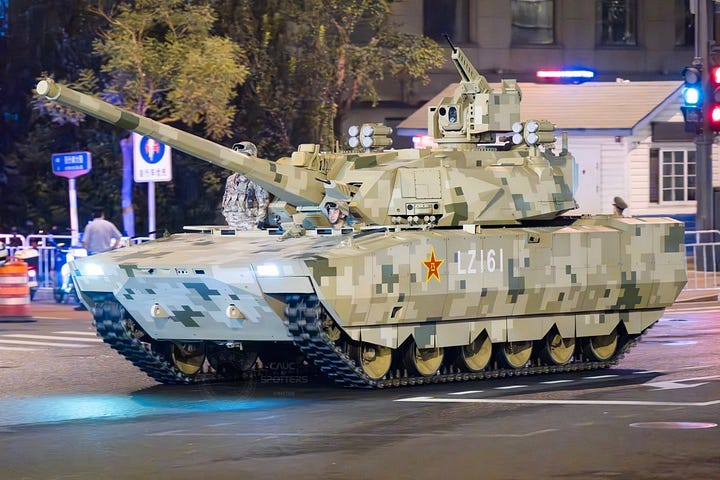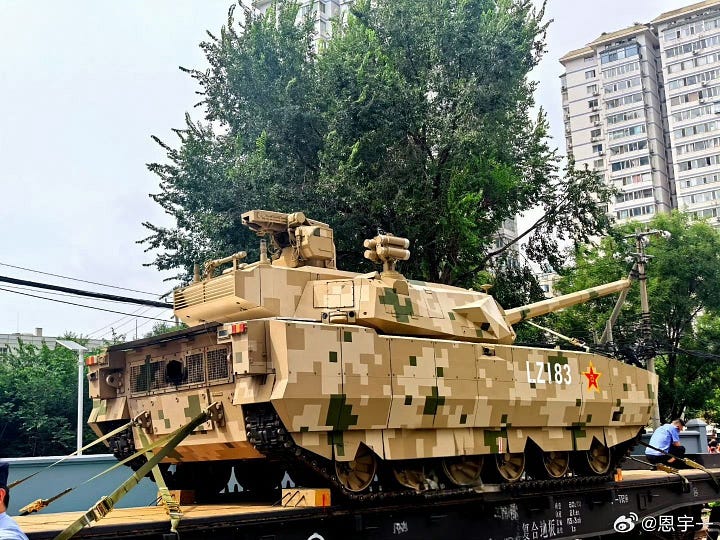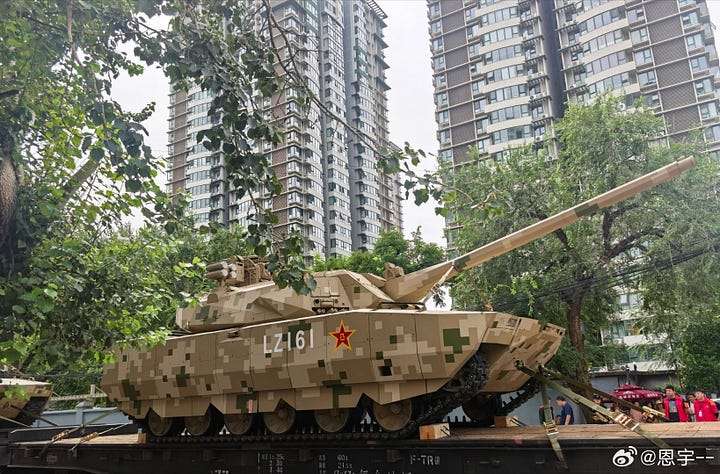Note: The following text was originally posted on my X/Twitter account.
One of the Chinese systems set to be formally unveiled at the forthcoming 3 September military parade is a new medium-weight tank design which may have the designation ZTZ-201. Much can be said about the ZTZ-201 and recent trends in Chinese armoured combat vehicle design more generally. Given evolving battlefield dynamics—above all, the all-aspect shaped charge threat brought about by armed “FPV” multirotor drones—it is important to recognize that active protection systems (APS) such as the system installed on the ZTZ-201 are not an unalloyed good and are not optimized against the quantitatively distinct all-aspect shaped charge threat even if APS designs are suitably modified to intercept the qualitatively distinct threat that is an armed “FPV” multirotor drone.




The ZTZ-201 may be one of the first armoured combat vehicles to not only be equipped with an APS—which is similar in appearance to the previously unveiled Chinese GL-6—but an APS oriented to facilitate the interception of armed multirotor drones and similar that can undertake a low-velocity top-attack profile that is very distinct from the top-attack profiles of existing anti-tank missiles. With such an (automated) APS installed, the crew of an armoured combat vehicle such as the ZTZ-201 can, in principle, defend themselves against attack by multiple munitions, including the uncrewed aircraft-turned-single-use munitions known as armed “FPV” multirotor drones. There is, however, a downside to installing extant APS designs on an armoured combat vehicle: militaries can no longer make practical use of standoff/slat armour and similar in the manner that both Russia and Ukraine have taken to extreme levels to protect vehicles against sustained/repeated attacks by large numbers of inexpensive armed “FPV” multirotor drones.
Standoff/slat armour and similar amount to fairly simple and inexpensive ways of bolstering vehicular armour in general and defeating the qualitatively distinct (new) threat posed by fairly slow and light armed (single-use) multirotor drones equipped with shaped charge warheads. In the specific context of the Russia-Ukraine War, such armed multirotor drones are primarily equipped with modified PG-7 shaped charge warheads—which are ordinarily used with RPG-7 launchers—in which an ersatz, often wire, contact/impact fuze replaces the original piezoelectric contact/impact fuze. Simply stated, both Russia and Ukraine use standoff/slat armour and similar to (A) increase the probability of a collision between the armed multirotor drone’s airframe and the vehicle and (B) increase the probability that the shaped charge warhead detonates prematurely/when oriented toward a non-critical area of the vehicle, etc. It is important to note that shaped charge warheads of both the Munroe effect and Misnay-Schardin effect varieties have highly directional and highly concentrated kinetic destructive effects against vehicular armour—much of the blast effects and physical effects of fragmentation are essentially incidental in nature and tend to be inadequate to damage an armoured combat vehicle or injure/kill its occupants. Given the above, militaries can seek to defeat the shaped charge warhead and its fusing mechanism and/or defeat the uncrewed aircraft-turned-munition that is an armed “FPV” multirotor drone. With APS, the focus is primarily on defeating the munition/projectile rather than the warhead, which is the primary purpose of standoff/slat armour.
The new Chinese ZTZ-201 is equipped with two roof-mounted APS munition launchers. These launchers are trainable in elevation and traverse, and each is loaded with four APS munitions (which are used to "shoot down" inbound objects). That is, this APS can intercept no more than eight inbound munitions—including armed “FPV” multirotor drones—before it must be reloaded. While eight may not sound like a very large number, it is important to recognize that this is a universal shortcoming of extant APS systems and is reflective of the fact that the APS munitions are not so small or light such that the APS will be able to intercept dozens of inbound munitions (not necessarily simultaneously) when installed on/in the limited real estate found on an armoured combat vehicle. The new Chinese ZTZ-201 design has a particular disadvantage given that it (A) appears to have an uncrewed turret and (B) accommodates its likely three crewmembers in a compartment in the hull that is located in front of the turret. Simply stated, an appealing design feature that is intended to, among other things, improve crew survivability and, in so doing, complement the protection afforded to the crew by the APS results in the crew being unable to readily reload the roof-mounted APS launchers.
As with essentially all military systems, no active protection system is going to offer hermetic protection on an indefinite basis, and all such designs are optimized against a specific set of threats and combat scenarios. Relevant considerations for militaries and designers include how many munitions a given vehicle is likely to encounter in a typical engagement and the nature of the inbound munitions/projectiles. As noted earlier, armed “FPV” multirotor drones constitute a qualitatively distinct type of threat to armoured combat vehicles that did not previously exist. While the shaped charge threat itself is not new—shaped charges have been in constant use since 1940, which makes the shaped charge threat to armoured combat vehicles an 85 year old problem for militaries and armoured combat vehicle designers—the all-aspect shaped charge threat is new, and inexpensive and plentiful armed “FPV” multirotor drones built with commercial off the shelf components are now being used in incredibly large numbers that even late Cold War armoured combat vehicle designers likely could not fathom.
It is hardly unusual for an armoured combat vehicle in the Russia-Ukraine War to encounter a dozen or more armed “FPV” multirotor drones in a given engagement. When it comes to tanks and other heavily armoured vehicles, it is not unusual for multiple armed “FPV” multirotor drone strikes to only inflict limited damage, but the numbers are likely to eventually add up, no matter how much standoff/slat armoured—as well as explosive reactive armour—is installed. Given such dynamics, the threat to armoured vehicles is no longer primarily a function of the quality of inbound munitions but the quantity of inbound munitions. All extant APS designs, which are primarily optimized against anti-tank missiles and similar (and, in some cases, very high velocity kinetic APFSDS projectiles fired from the main gun of a tank) even if the APS is capable of detecting and intercepting a qualitatively different—much slower and top-attack capable—threat in the form of an armed “FPV” multirotor drone equipped with a shaped charge warhead.
As with essentially all military systems, APS are good for up to n+1 engagements. The value for n varies, but it is always a finite quantity. With extant APS, including the APS installed on the new Chinese ZTZ-201, the value for n tends not to be very large, not least in a context in which armed “FPV” multirotor drones are very inexpensive and, as such, very plentiful in a manner that anti-tank missiles have never been.
New medium-weight armoured vehicles such as the new Chinese ZTZ-201 are at a particular disadvantage against the threat posed by inexpensive and plentiful armed “FPV” multirotor drones. When an existing heavy-weight tank is upgraded with an APS, the upgrade typically does not include the reduction of the protection offered by the preexisting vehicular armour. There is, therefore, a decidedly imperfect fallback in the event that the active protection system fails, misses, and/or runs out of ready-to-fire munitions. This is not the case with the ZTZ-201, which may be subject to multiple impacts from shaped charge warheads if/when the active protection system runs out of ready-to-fire munitions. Given available imagery, the n+1 for the ZTZ-201 may be just nine.
To be clear, none of this is to say that a hypothetical tenth armed “FPV” multirotor drone will severely damage, let alone destroy, a ZTZ-201 after the first eight armed “FPV” multirotor drones are intercepted by the APS. Real-world scenarios are a lot more complex than that. Even so, the limitations of extant APS against the quantitatively and qualitatively distinct threat posed by inexpensive and plentiful armed “FPV” multirotor drones should be clear.
If the ZTZ-201 were not equipped with an APS, the vehicle could readily accommodate standoff/slat armour and similar, including the likes of roof-mounted explosive reactive armour panels similar to what has been widely employed in the Russia-Ukraine War. The presence of an active protection system on the ZTZ-201, however, essentially precludes such an approach, given that the four turret-mounted active radar sensors must have an unobstructed line of sight on inbound threats to function, and the two trainable (in elevation and traverse) roof-mounted active protection system munitions launchers similarly require an unobstructed line of sight on inbound threats to function. The combined commander’s panoramic sight and remote weapon station similarly require an unobstructed line of sight on inbound threats to function as intended. Simply stated, there is little scope for installing standoff/slat armour and similar on the ZTZ-201 in this particular configuration.
All things considered, the design approach encapsulated in the ZTZ-201 has merit—other countries and non-Chinese armoured combat vehicle designs are heading in the same general direction if they are not there already. Most active protection systems were, however, designed long before inexpensive and plentiful armed “FPV” multirotor drones entered the fray and resulted in a qualitatively and quantitatively new all-aspect manifestation of the longstanding threat posed by shaped charge warheads. Given the restrictions imposed by the very existence of an active protection system on an armoured combat vehicle, there is a case to be made that the trade-offs may not necessarily be worthwhile in all combat situations unless and until active protection systems—which may or may not function in a very different manner than extant APS—become available with much greater magazine depth/a much larger number of ready-to-fire APS munitions.
An update from 21 August 2025:
While the remote-controlled weapon system (RCWS)—installed on the roof of the new Chinese ZTZ-201 medium-weight tank can, in principle, be used to shoot down multirotor drones and similar fairly slow aerial threats, it is slaved in traverse—but not elevation—to the commander's panoramic sight. In principle, the active protection system (APS) can be configured to override the commander's control over the panoramic sight, but that is hardly an ideal measure in combat. This is a trade-off that comes with combined commander's panoramic sights + RCWS—the alternative is to have line-of-sight restrictions for the commander's panoramic sight and/or the RCWS.

